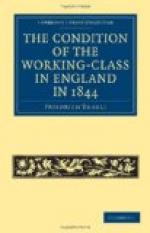of Drury Lane Theatre, the second in London, are some
of the worst streets of the whole metropolis, Charles,
King, and Park Streets, in which the houses are inhabited
from cellar to garret exclusively by poor families.
In the parishes of St. John and St. Margaret there
lived in 1840, according to the Journal of the
Statistical Society, 5,366 working-men’s
families in 5,294 “dwellings” (if they
deserve the name!), men, women, and children thrown
together without distinction of age or sex, 26,830
persons all told; and of these families three-fourths
possessed but one room. In the aristocratic
parish of St. George, Hanover Square, there lived,
according to the same authority, 1,465 working-men’s
families, nearly 6,000 persons, under similar conditions,
and here, too, more than two-thirds of the whole number
crowded together at the rate of one family in one room.
And how the poverty of these unfortunates, among
whom even thieves find nothing to steal, is exploited
by the property-holding class in lawful ways!
The abominable dwellings in Drury Lane, just mentioned,
bring in the following rents: two cellar dwellings,
3s.; one room, ground-floor, 4s.; second-storey, 4s.
6d.; third-floor, 4s.; garret-room, 3s. weekly, so
that the starving occupants of Charles Street alone,
pay the house-owners a yearly tribute of 2,000 pounds,
and the 5,336 families above mentioned in Westminster,
a yearly rent of 40,000 pounds.
The most extensive working-people’s district lies east of the Tower in Whitechapel and Bethnal Green, where the greatest masses of London working-people live. Let us hear Mr. G. Alston, preacher of St. Philip’s, Bethnal Green, on the condition of his parish. He says:
“It contains 1,400 houses, inhabited by 2,795 families, or about 12,000 persons. The space upon which this large population dwells, is less than 400 yards (1,200 feet) square, and in this overcrowding it is nothing unusual to find a man, his wife, four or five children, and, sometimes, both grandparents, all in one single room, where they eat, sleep, and work. I believe that before the Bishop of London called attention to this most poverty-stricken parish, people at the West End knew as little of it as of the savages of Australia or the South Sea Isles. And if we make ourselves acquainted with these unfortunates, through personal observation, if we watch them at their scanty meal and see them bowed by illness and want of work, we shall find such a mass of helplessness and misery, that a nation like ours must blush that these things can be possible. I was rector near Huddersfield during the three years in which the mills were at their worst, but I have never seen such complete helplessness of the poor as since then in Bethnal Green. Not one father of a family in ten in the whole neighbourhood has other clothing than his working suit, and that is as bad and tattered as possible; many, indeed, have no other covering for the night than these rags, and no bed, save a sack of straw and shavings.”
The foregoing description furnishes an idea of the aspect of the interior of the dwellings. But let us follow the English officials, who occasionally stray thither, into one or two of these working-men’s homes.




